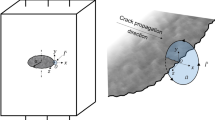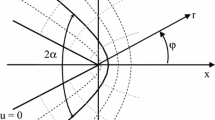Abstract
To study fracture initiation near notches experiments were conducted on polycarbonate at room temperature. It could be demonstrated conclusively that cracks are nucleated under the influence of a critical normal stress at the elastic-plastic boundary. Slip line field theory allows the determination of the critical normal fracture stress from the knowledge of the notch root radius and the location of the crack nucleation. For 0.5 in. thick specimens with root radii between 0.001 and 0.01 in. the calculated critical fracture stress of polycarbonate is nearly constant, 21.2 ±0.6 ksi. An analysis of the data in accordance with the theory developed by R. Beeuwkes, Jr. for parabolic notches resulted in critical fracture stress values of approximately 21.5 ksi. Specimens with central holes between 0.04 and 0.05 in. diam also showed crack nucleation below the surface of the hole but the calculated critical fracture stress values were considerably lower, approximately 11.2 ksi. This may be attributed to the loss of plane strain conditions in these 0.5 in. thick specimens. The experimentally observed slip lines in polycarbonate are not orthogonal to each other but intersect at a lower (~80 deg) angle. This may be due to the relief of stresses on unloading and sectioning, and it may indicate that plane strain conditions were not present. Because of its flow characteristics, which are similar to those of metals, and because of its transparency, polycarbonate appears to be a good model material for the study of plastic flow initiated brittle fracture. It could be used to check the theoretical slip line field solutions proposed for a variety of loading conditions.
Similar content being viewed by others
References
1. Lame Navier:Paris Mem. Par. Divers Savants, 1833, t-4.
2. P. Ludwik:Elemente der Technologischen Mechanik, Berlin, 1909.
J. A. Hendrickson, D. S. Wood, and D. S. Clark:Trans. ASM, 1958, vol. 50, p. 656.
J. F. Knott and A. H. Cottrell:J. Iron Steel Inst., 1963, vol. 201, p. 249.
A. S. Tetelman, T. R. Wilshaw, and C. A. Rau, Jr.: Proc. Int. Symp. on Fracture Mechanics, Kiruna, Sweden, August 1967.
J. A. Hendrickson, D. S. Wood, and D. S. Clarke:Trans. ASM Soc. Met., 1959, vol. 51, p. 629.
R. Beeuwkes, Jr.: Proc. of the Third Sagamore Conf. on Materials Evaluation in Relation to Component Behavior, 1956, p. 89.
R. Beeuwkes, Jr.:Surfaces and Interfaces, Syracuse University Press, vol. II, 1968.
J. F. Knott:J. Iron Steel Inst., 1966, vol. 204, p. 104.
J. F. Knott:J. Iron Steel Inst., 1967, vol. 205, p. 966.
V. Weiss: inFracture an Advanced Treatise in Seven Volumes, vol. III, H. Liebowitz, ed., p. 34, Academic Press, 1970.
R. Chait: Ph.D. Dissertation, Syracuse Univeristy, March 1967.
R. Hill:Mathematical Theory of Plasticity, Oxford, London, 1950.
D. N.de G. Allen and Sir. R. Southwell:Royal Soc, London, Phil. Trans., 1949, Series A, vol. 242, p. 379.
W. Hu: M. S. Thesis, Syracuse University, March 1969.
A. P. Green and B. B. Hundy:J. Mech. Phys. Solids, 1956, vol. 4, p. 128.
T. R. Wilshaw and P. L. Pratt:J. Mech. Phys. Solids, 1966, vol. 14, p. 7.
C. A. Griffis and J. W. Spretnak: Ohio State University Research Foundation Technical Report AFML-TR-68-269, October 1968.
T. R. Wilshaw:J. Iron Steel Inst., 1966, vol. 202, p. 936.
D. L. Herrod, T. F. Hengstenberg, and M. J. Manjoine:J. Mater. JMLSA, 1969, no. 3, vol. 4, p. 618.
R. K. Govila:Acta Met., 1969, vol. 17, p. 1209.
G. Jacoby and C. Cramer: Tech. Report No. 47, Institute for the Study of Fatigue and Reliability, Columbia University, April 1967.
R. P. Kambour:Polym., 1964, vol. 5, p. 143.
G. Menges and H. Schmidt:Plast. Plym., Feb. 1970, p. 13.
Author information
Authors and Affiliations
Rights and permissions
About this article
Cite this article
Garde, A.M., Weiss, V. Brittle crack initiation at the elastic-plastic interface. Metall Trans 3, 2811–2817 (1972). https://doi.org/10.1007/BF02652847
Received:
Published:
Issue Date:
DOI: https://doi.org/10.1007/BF02652847




